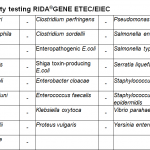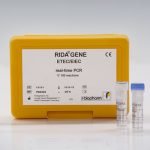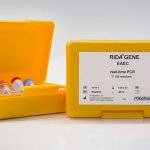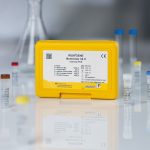Intended use:
For in vitro diagnostic use. RIDA®GENE ETEC/EIEC is a multiplex real-time PCR for the direct, qualitative detection and differentiation of the virulence-factor genes of ETEC and EIEC/Shigella spp. in human stool samples and cultures. RIDA®GENE ETEC/EIEC multiplex real-time PCR is intended for use as an aid in diagnosis of gastroenteritis caused by pathogenic Escherichia coli and Shigella spp., respectively.
General information:
Escherichia coli (E. coli) are gram negative, facultatively anaerobic rod bacteria, which move by peritrichal flagellation and belong to the Enterobacteriaceae family.
E. coli are part of the normal intestinal flora of humans and many farm animals and are generally nonpathogenic. Some E. coli strains are pathogenic to humans through the acquisition of certain virulence factors (e.g. genes for toxins).
The six known intestinal pathogenic E. coli: enterohemorrhagic E. coli (EHEC), enteropathogenic E. coli (EPEC), enterotoxic E. coli (ETEC), enteroinvasive E. coli (EIEC), EAEC enteroaggregative E. coli und diffusely adherent E. coli (DAEC) can be differentiated by the virulence factors.
Enterotoxigenic E. coli (ETEC) are important intestinal pathogenic E. coli. ETEC is the most common cause of traveller’s diarrhea that affects persons travelling to developing countries. 30 – 60 % of all traveller’s diarrhea cases are caused by ETEC. 11 – 16 % of returning travellers from developing countries are infected by ETEC. Among children below 5 years of age in developing countries, ETEC accounts for about 210 million cases of diarrhea and about 380,000 deaths annually. ETEC has two important diagnostic virulence factors. They are capable to produce heat stable (ST) and/or heat labile (LT) enterotoxins. The clinical symptoms which are caused by ETEC range from mild to acute watery diarrhea, which fade without any specific therapy. Life-threatening cases of ETEC diarrhea occur mostly in weanling infants in the developing countries. Sources of infection are contaminated water and food, whereas infective chains from human to human can be excluded so far.
Enteroinvasive E. coli (EIEC) are responsible for Shigellose-like disease in developing countries and among travellers to these less developed regions. EIEC strains are biochemically and genetically related to Shigella spp. The pathogenic features of EIEC and Shigella spp. are based on plasmid-mediated capability to invade the colonic epithelium for destruction. By the detection of the ipaH gene (invasion plasmid antigen H gene) EIEC/Shigella spp. can be differentiated from ETEC. A differentiation between EIEC and Shigella spp. is not recommended, because both have the same clinical relevance. Shigellose caused by EIEC is characterized by abdominal pain and watery diarrhea, sometimes containing blood. Sources of infection are contaminated water, food and infective chains from human to human.
Image Gallery
| Art. No. | PG2225 |
|---|---|
| Test format | real-time PCR with 100 reactions |
| Shelf life | 24 months after production |
| Sensitivity | Analytical Sensitivity LT: ≥ 10 DNA copies per reaction ST: ≥ 10 DNA copies per reaction ipaH: ≥ 10 DNA copies per reaction |
Dear customers,
we have started to provide the documents for our products in an electronic format. These are the Instructions for Use (IFU), the Safety Data Sheets (SDS) and the Certificate of Analysis (CoA). For batches placed on the market after 01 January 2023, you can find our documents on the eIFU portal eifu.r-biopharm.com/clinic.












